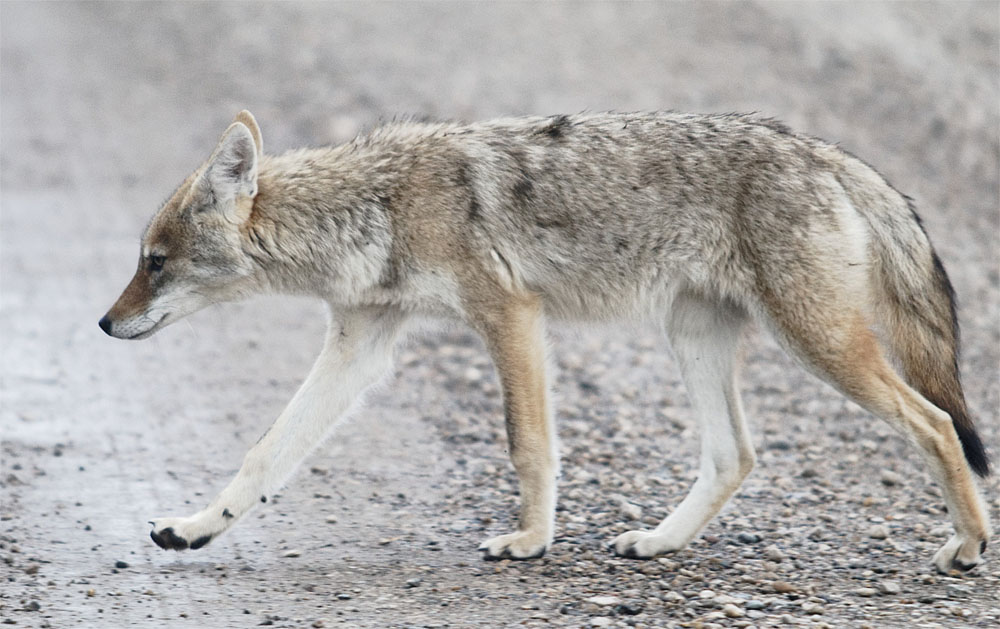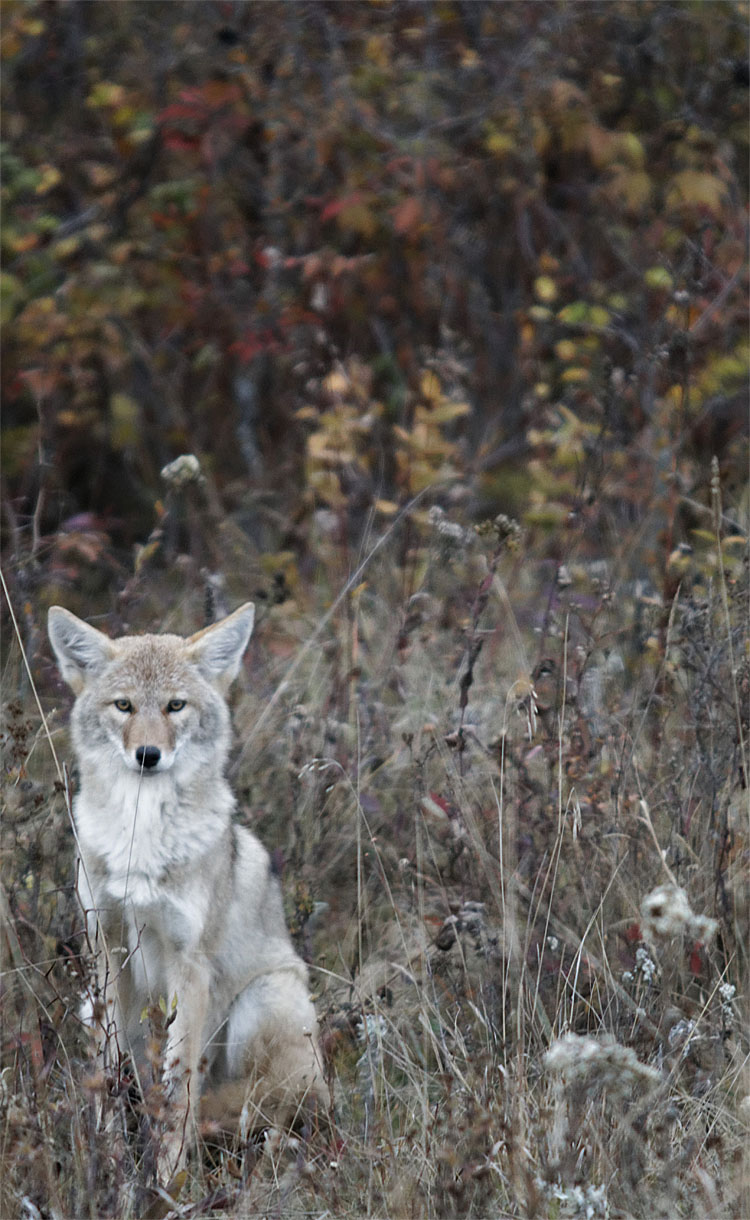September 2018
Could we ever spend a hour looking through the eyes of a coyote? I think it would overwhelm us. We see the wild in passing, usually from a car these days. The coyote hears it, smells it, lives it. The stories that they could tell!

It’s the last evening in the park for me. And I could ask for nothing more: a family of coyotes in the fescue prairie west of Riding Mountain, resting and watching, as coyotes do.
And wandering a little.

Coyotes are omnivorous, just like foxes and bears. Berries are on the menu tonight!

Four coyotes? Perhaps more. Certainly three adults and a pup.

They’re waiting for winter. I’m waiting to travel again. Hard to believe, just eight days and so much wildness. Now we’re bound for Toronto and the long journey home.
I had some concerns about returning here after my long absence, afraid that the old essence had become diluted by relentless over-development and over-tourism. And there are problems, it is true; not on the scale of what Jasper and Banff are enduring, but even the prairie hasn’t escaped commercialism. I was especially concerned at the new road being built in East Block of Grasslands, a highly questionable action that seems to have gone unnoticed by Canadian NGOs. And Canada’s federal and provincial biodiversity protection laws could be tightened up. That is not news. Nor is the bubbling friction between people and large wildlife in some rural districts.
But there is still so much life in the Great Lone Land. Taste of the air or the glow of a lynx’s eyes? Hear it in the coyote’s song and the catch the shadow of an owl on a forgotten farmstead. It is something, intangible and free. Coyote, bears, moose, prairie dogs – they’re still here.
Long may they remain so.
Amen. May there always be enough space for our wild brethren.
LikeLiked by 2 people
Our world is so much richer for sharing it with them.
LikeLiked by 2 people
Agreed.
LikeLiked by 2 people
“…afraid that the old essence had become diluted by relentless over-development and over-tourism.”
Exactly. One of the probably most brutal consequences to a wildlife and a back country is probably what has happened to Joffrey Lakes near Pemberton, BC. Old trail was going through a boulder field that was not that easy to pass and for some people it was a deterrent; then BC Parks made a terrible mistake – they made a new trail that is going around boulder field and made those beautiful lakes accessible to almost everyone. Now, on an average day, you can see cars parked 2km up and down from the small parking lot, along the highway and endless lines of people going up and down the trail. And many of them frustrated because they couldn’t find a parking or a good spot for a photograph/selfie. Disaster is not a strong word to describe what is going on there. It has been years since we were there last time and I don’t think we will go anytime soon.
Over-tourism make people go further into the back country and deeper into the wild life territory. And I am afraid what will happen in the future because it will not end well. In our self centered world, most people just want to make a good selfie, without paying much attention or care to preserve that beautiful wilderness around.
LikeLiked by 2 people
That is a sad example, and similar to what I feel about Grasslands: yes, it is difficult to reach and formerly had limited accommodation options / guided tours etc, but that was exactly what attracted the kind of people who would go there for the right reason and treat it with respect. Now, they’re in danger of not only putting the wildlife under stress with uncontrolled visitation, but there’s a danger of people not understanding the very real risks. One man died last year while trying to hike the 80km ecotour alone, and while I don’t know the circumstances – possibly he was experienced and just had a tragic accident – I fear that avoidable deaths are just a matter of time. The prairies are brutal and their dangers are quite different to those of the mountains.
I have also been thinking recently that almost invariably when Parks Canada posts on Facebook, it’s pleading for visitors in one way or another. What a contrast to, say, Katmai in Alaska, which posts about wildlife and conservation 95% of the time. Or the Polish national parks. I do wonder where we are headed as well, to be honest.
LikeLiked by 1 person
It seems like WordPress is acting again. I made a comment and now I can’t see it. Let me know if it is here and if not I will post again. Thanks 🙂
LikeLiked by 1 person
Aagh, what is the matter with WP? I found your comment in the filter but it’s beyond me why it put it there in the first place. Please let me know if it happens again. Hopefully it won’t…
LikeLike
I think that the longer a comment is, the more possibly it will end up in a junk folder or stuck in filter waiting for confirmation. Usually, if there is a link to some web site in a comment it would trigger a spam filter but this time it might have been the quotes (“) and the length of a comment. Although, I am not sure.
LikeLiked by 2 people
Yes, that makes sense. Although, an option to add people to a ‘safe commenter’ list would be useful.
LikeLike
Adele, what beautiful Cayotes you found! Wonderful to see! Long may they endure!
LikeLiked by 2 people
Thanks Robin. That was a wonderful sighting. They were so peaceful.
LikeLike
I find it hard to understand why nature-based tourism cannot be managed so it doesn’t destroy what people purport to be seeking? I agree that for many, wild places are just another theme park venue, and in many ways they would prefer a lot of the wildness to be “tamed” or tarred to make it more like where they come from. And in too many places such preferences are catered for.
Anyway despite all the worries, it is good to celebrate those exquisite coyotes. Your lovely pictures convey something of their wild wariness and grace (from which I wish we might learn some humility). Yes indeed, long may they remain intangible and free, along with the other creatures and spaces to which we owe respect. Thanks.
LikeLiked by 2 people
Indeed, and it is a global problem, as is the behaviour of theme park-minded tourists.
Thank you 🙂 It was a wonderful gift to spend time in their company. It must be very snowy by those bushes by now so I hope they are leaving coyote tracks under the stars.
LikeLiked by 1 person
That is a beautiful image to have in mind, and I hope they fare well through the winter.
LikeLiked by 1 person